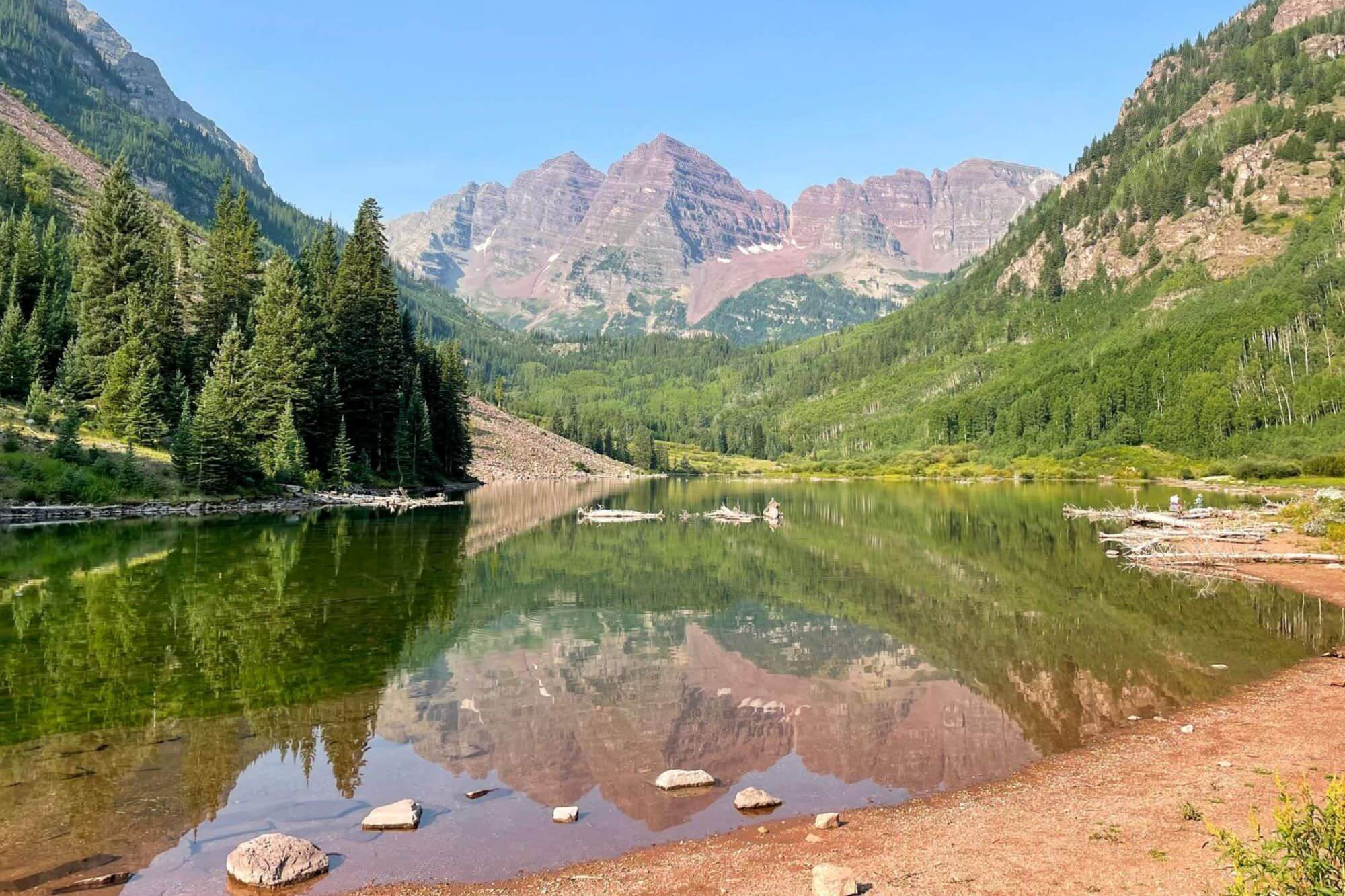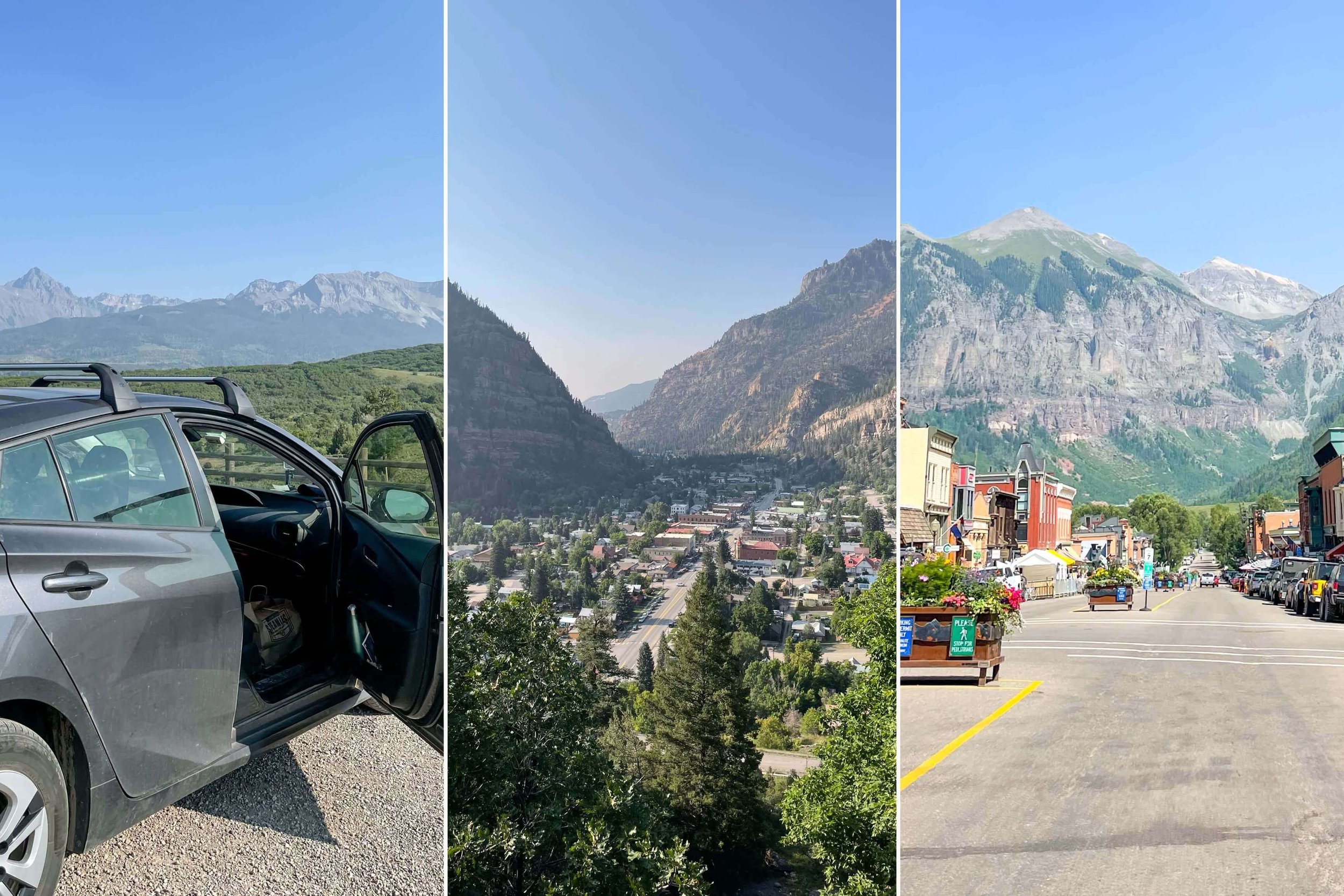Driving Trail Ridge Road in RMNP
If you only have time for one scenic drive in Rocky Mountain National Park, make it Trail Ridge Road. This epic high-altitude route climbs above the trees and stays there, delivering nonstop views of jagged peaks, alpine tundra, and dramatic drop-offs.
Known as the "Highway to the Sky," Trail Ridge Road is the highest continuous paved road in the United States. It crosses the Continental Divide at over 12,000 feet and links the park's east and west sides, offering a true Rocky Mountain National Park experience in a single drive.
In this guide, we’ll walk you through everything you need to know about Trail Ridge Road: must-see stops, seasonal closures, driving tips, suggested itineraries, and how to make the most of your time!
Table of Contents Hide
What is Trail Ridge Road?
Trail Ridge Road is a 48-mile scenic route through Rocky Mountain National Park that stretches from Estes Park (east side) to Grand Lake (west side). It climbs from montane forests into subalpine and alpine zones, topping out at 12,183 feet near Fall River Pass.
This drive is perfect for first-time visitors, road trippers, and anyone who wants to experience a wide range of the park’s ecosystems without a long hike. You can explore waterfalls, pullouts, overlooks, visitor centers, and short trails right from the road.
Overview of the Route
Here’s a general breakdown from east to west:
1. Estes Park to Many Parks Curve
Scenic meadow views and elk sightings
Deer Ridge Junction: access to Bear Lake Road and home to the popular Deer Mountain Trail (we loved the Deer Mountain Trail, it’s a great place to stretch your legs and enjoy beautiful views!)
Many Parks Curve Overlook: great photo stop with sweeping views of the surrounding peaks and valleys
2. Many Parks Curve to Alpine Visitor Center
Rainbow Curve Overlook
Forest Canyon Overlook: A great spot for photography!
Rock Cut and Tundra Communities Trail (great short hike above 12,000 feet)
Trail Ridge Summit (12,183 ft)
Gore Range Overlook
Alpine Visitor Center (restrooms, shop, exhibits, food)
3. Alpine Visitor Center to Grand Lake
Medicine Bow Curve
Milner Pass (Continental Divide crossing)
Fairview Curve Overlook
Kawuneeche Valley: moose sightings and access to Colorado River Trail
Grand Lake: charming mountain town and park gateway
Trail Ridge Road Map
Here’s an overview map of Trail Ridge Road.
Key tips:
There are no gas stations inside the park; fill up in Estes Park or Grand Lake (both towns designated with stars in the map above) before entering.
Alpine Visitor Center (toward the top middle of the map) is your best bet for food/restrooms.
Bear Lake Road is a spur road near the east end. Combine the two if you have time and have a Timed Entry + Bear Lake Road reservation.
Cell service is limited, especially in high-elevation areas. We like to download offline maps ahead of time and pick up a physical map at the park entrance gates or visitor centers when we arrive.
When is Trail Ridge Road Open?
Trail Ridge Road typically opens in late May and closes for the season by mid-October, depending on snowpack. It’s best experienced in late June through September, when the entire route is open and wildflowers are blooming.
Always check road status before your trip on the NPS website or by calling the park info line. Snowstorms can temporarily close the road even in midsummer. Old Fall River Road usually opens later in the summer. For example, in 2025, Old Fall River Road opened for the season on Friday, July 4th.
🎯 RTL Tip: If you’re hoping to drive both scenic roads, visiting late July through September is typically best.
1-Day Trail Ridge Road Itinerary
Starting in Estes Park (East to West):
Enter RMNP via Beaver Meadows Entrance Station
Stop at Many Parks Curve Overlook for panoramic views
Stretch your legs (and get a restroom break!) at Rainbow Curve Overlook
Stop at Forest Canyon Overlook & Trail (incredible views)
Hike the Tundra Communities Trail (0.6 mi one way) for a high-altitude tundra walk
Visit Alpine Visitor Center (break for lunch/snacks & enjoy the views)
Take in views at Gore Range and Fairview Curve
Look for moose in Kawuneeche Valley
End in Grand Lake (grab a bite, walk along the lake, or explore the town)
Optional detours
Bear Lake Road: Add scenic lakes and trailheads on the east side (requires timed-entry reservation).
Colorado River Trail: On the west side, take a peaceful hike along the headwaters of the Colorado River.
Old Fall River Road (Bonus!): This one-way dirt road offers a more rugged, historic route up to the Alpine Visitor Center. It’s open seasonally (usually early July through September) and features waterfalls, picnic areas, and fewer crowds. A fantastic alternative or loop option if you want to avoid backtracking. (Consider driving Old Fall River Road from Estes Park to Alpine Visitor Center, and taking Trail Ridge Road on your way back to Estes Park. If you’re coming from Grand Lake, then take Trail Ridge Road on your way out, and Old Fall River Road for your return.)
Driving Times & Distances
Estes Park to Alpine Visitor Center: 22 miles / ~1 hr (without stops)
Alpine Visitor Center to Grand Lake: 26 miles / ~1 hr
Estes Park to Grand Lake (full drive): 48 miles / ~2 hrs total (without stops & traffic)
Rainbow Curve to Alpine Visitor Center: 11 miles / ~30 min
Kawuneeche Valley segment: 10 miles / ~20–30 min (moose watching adds time!)
Expect slowdowns for wildlife, congestion, and road work. It’s not a drive to rush, so plan for 4–5 hours with stops.
FAQs: Trail Ridge Road
Q: Is Trail Ridge Road paved?
Yes! Trail Ridge Road is fully paved and maintained by the National Park Service. While it's a high-mountain road with sharp turns, steep drop-offs, and no guardrails in some sections, it does not require four-wheel drive. That said, drivers should take it slow and watch for wildlife crossings.
Q: Can RVs drive Trail Ridge Road?
Yes, RVs and trailers are allowed on Trail Ridge Road, but there are important caveats. The road includes steep grades, sharp curves, and narrow shoulders, especially near the summit. The National Park Service recommends a max length of 40 feet for single vehicles and 25 feet for trailers to safely navigate the road.
Q: How long does it take to drive Trail Ridge Road?
Without stops, driving the full 48-mile stretch takes about 2 hours. However, we recommend spending at least half a day to a full day exploring the route, so you have time for photo stops, scenic viewpoints, short hikes, wildlife sightings, and a break at the Alpine Visitor Center.
Q: Can you drive Trail Ridge Road in one day?
Yes! Trail Ridge Road is ideal for a one-day adventure. You can drive it point to point (Estes Park to Grand Lake or vice versa) or make it a round-trip loop. Be sure to plan for extra time if you're adding hikes or detours like Bear Lake Road or Old Fall River Road.
Q: What are must-see stops along Trail Ridge Road?
Don’t miss Rainbow Curve, Forest Canyon Overlook, Rock Cut, the Tundra Communities Trail, Alpine Visitor Center, Gore Range Overlook, and Kawuneeche Valley. These stops highlight the road’s incredible variety.
Q: Where can I stop for food or restrooms?
The Alpine Visitor Center (near the highest point of the drive) offers restrooms, grab-and-go food, souvenirs, and indoor exhibits. Estes Park and Grand Lake both have a wide range of dining options and full-service restrooms. Other stops have vault toilets but no food or water.
Q: Are there hiking trails along the route?
Yes, some highlights include:
Tundra Communities Trail (0.6 miles one way): short, paved, and interpretive with great views
Alpine Ridge Trail (0.6 miles round trip): steep but rewarding views from the Visitor Center
Ute Trail (moderate): a high-elevation hike across open tundra
Colorado River Trail (easy): located on the west side, offering a peaceful forest walk along the river
Q: What wildlife can you see?
Elk and marmots are commonly seen along the eastern portion, especially near sunrise or sunset. The west side (Kawuneeche Valley) is your best bet for spotting moose. Pika, bighorn sheep, and even the occasional black bear or coyote may also make appearances. Always maintain distance and never feed wildlife.
Q: What’s the best direction to drive it?
Driving east to west (from Estes Park to Grand Lake) offers a more dramatic ascent into the alpine tundra and feels like a big reveal. But both directions are beautiful and offer unique views. If you're returning to your starting point, consider looping with Old Fall River Road or planning one direction for early morning (to avoid crowds) and then return later in the day.
Q: Should I worry about the altitude?
Trail Ridge Road reaches over 12,000 feet, and altitude sickness is a real possibility, especially if you're coming from sea level. Symptoms include dizziness, headache, nausea, and shortness of breath. Drink plenty of water, eat light meals, and avoid strenuous activity on your first two days in town. We also recommend bringing warm layers even in summer, as temperatures can drop quickly, and afternoon thunderstorms are common.
Q: Do I need a timed-entry reservation?
Yes, if entering Rocky Mountain National Park between late May and mid-October, you’ll need a timed-entry permit. Trail Ridge Road is part of the "Park Access" permit. Bear Lake Road requires a separate one. Reservations cost a $2 non-refundable fee, are vehicle-specific (only one per vehicle per day), and must be obtained in advance through Recreation.gov. New time slots are released on the first of each month and evening-of-entry slots release at 7 p.m. MDT the night before. Learn more about timed-entry reservations here.
Q: What if I don’t have a timed-entry reservation?
If you don’t have a timed-entry permit for Rocky Mountain National Park, you can still access Trail Ridge Road before 9 a.m. or after 2 p.m. daily. These are the unrestricted hours during the reservation season (typically late May through mid-October), so early birds and late-afternoon visitors can enter without a reservation. Just remember, you still need to pay the park entrance fee or have an America the Beautiful pass.
Q: What is Old Fall River Road?
Old Fall River Road is a seasonal, one-way dirt road that predates Trail Ridge Road and offers a more rustic driving experience. It climbs from Horseshoe Park to the Alpine Visitor Center with tight switchbacks, waterfalls, and fewer crowds. Open from early July to late September, it’s suitable for most cars but not recommended for RVs, trailers, or low-clearance vehicles. Consider taking Old Fall River Road up (from the Estes Park side; it’s a one-way road) and Trail Ridge Road down for a scenic loop.
Q: Are there any campgrounds or lodges along Trail Ridge Road?
There are no lodges or hotels inside Rocky Mountain National Park, but you’ll find plenty of places to stay just outside the park in Estes Park (east side) and Grand Lake (west side). Both towns offer a wide range of accommodations, from cozy cabins and historic inns to full-service hotels and vacation rentals. We loved staying in Winter Park, near Grand Lake, during our Colorado Road Trip. It was easy to visit Rocky Mountain National Park from there, and the drive past Grand Lake into the park was beautiful.
As for camping, RMNP has five vehicle-accessible campgrounds:
East Side Campgrounds:
Moraine Park, Glacier Basin, and Aspenglen require reservations and are located near the Estes Park entrance.
Longs Peak Campground is tent-only, first-come, first-served, and open seasonally (July to early September).
West Side Campground:
Timber Creek Campground near Grand Lake is the only campground on the park’s west side. It’s reservation-only and a great base for exploring the Kawuneeche Valley.
🎯 RTL Tip: During our month in the area, we based ourselves in Winter Park, CO, and took day trips into the park (plus many other destinations in Colorado!). It gave us enough flexibility, easy access to both sides of Trail Ridge Road, and quieter evenings outside the park’s peak zones. See our full Colorado itinerary here.
Related Posts














This epic high-altitude route climbs above the trees and stays there, delivering nonstop views of jagged peaks, alpine tundra, and dramatic drop-offs. It’s one of the most awe-inspiring drives in any U.S. national park, and is the highest continuous paved road in the United States. Here’s what to know to go!